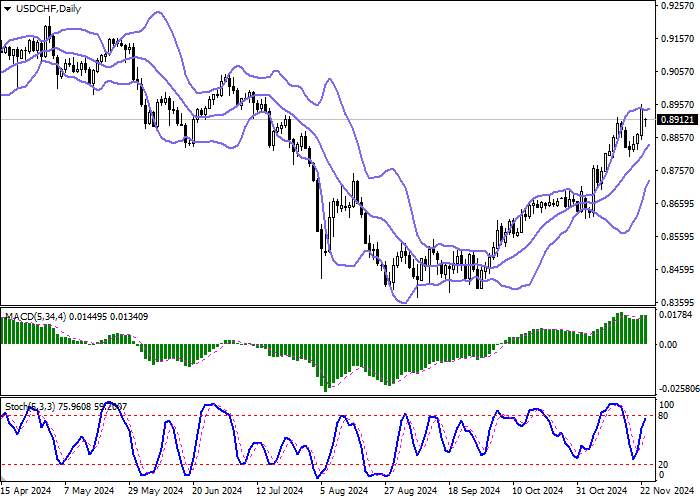Current trend
The USD/CHF pair is showing mixed trading, holding near 0.8910. The instrument opened with a small gap down after a sharp rise at the end of last week, especially on Friday, when the US dollar managed to update local highs from July 16, receiving support from macroeconomic statistics.
The US Services PMI in November rose from 55.0 points to 57.0 points with a forecast of 55.3 points, and the Manufacturing PMI — from 48.5 points to 48.8 points. At the same time, the Consumer Confidence Index from the University of Michigan in November fell from 73.0 points to 71.8 points, with expectations of 73.7 points. Business activity data came in positive, particularly against the backdrop of a sharp drop in similar indicators in the EU, where the European Central Bank (ECB) will now likely be forced to accelerate monetary easing.
In turn, Swiss industry has seen orders and sales fall as weak demand from European partners and the strong position of the franc have put pressure on exports, and companies believe that the negative dynamics will continue in the future, according to a survey by industry association Swissmechanic. Capacity utilisation at small Swiss manufacturing plants in an industry that accounts for around 18.0% of Gross Domestic Product (GDP) is now at 81.0%, the lowest since January 2021, with industrial sales falling 4.2% in the first nine months of the year. Already, about a third of such businesses have cut jobs, and others could follow suit, especially if US President-elect Donald Trump follows through with his plans to raise tariffs on imported goods. Meanwhile, pressure on the franc during trading last Friday was also exerted by the speech of the Chairman of the Swiss National Bank Martin Schlegel, who emphasized that the regulator will continue to fight high inflation. According to the official, the indicator in the target range of 0.0–2.0% is one of the key factors of the strength and stability of the national economy in recent years.
On Friday, at 10:00 (GMT 2), quarterly data on Gross Domestic Product (GDP) and the leading indicators index from the Swiss Economic Institute (KOF) for November will hit the market. The national economy is expected to maintain its previous growth dynamics of 0.7% quarterly and 1.8% year-on-year.
Support and resistance
Bollinger Bands on the daily chart show a steady increase. The price range is narrowing, reflecting the emergence of ambiguous dynamics of trading in the short term. MACD indicator is growing, while preserving a rather stable buy signal (located above the signal line). Stochastic is showing similar dynamics, but the line of the indicator is gradually approaching its highs, indicating the risks of overbought US dollar in the ultra-short term.
Resistance levels: 0.8935, 0.8957, 0.9000, 0.9037.
Support levels: 0.8900, 0.8865, 0.8827, 0.8800.


Trading tips
Short positions may be opened after a breakdown of 0.8900 with the target at 0.8827. Stop-loss — 0.8935. Implementation time: 1-2 days.
A rebound from 0.8900 as from support followed by a breakout of 0.8935 may become a signal for opening new long positions with the target at 0.9000. Stop-loss — 0.8900.





Hot
No comment on record. Start new comment.